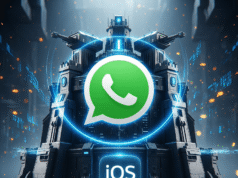The ongoing battle for smartphone supremacy between Google and Apple continues with Android 15 and Apple‘s latest OS representing distinct visions for mobile technology. Android emphasizes device diversity and customization, while Apple focuses on on-device intelligence and a streamlined ecosystem.
Android 15: Refinement Over Revolution
Android 15 prioritizes practical improvements over flashy features, focusing on enhanced privacy, theft protection, and optimized support for various Android devices, including foldables and tablets.
Key Features
Private Space – Creates a secure digital vault for sensitive apps and data, protected by a secondary authentication layer. Think of it as a hidden folder on steroids, completely isolated from your main profile.
Theft Detection and Remote Lock – Aims to deter thieves by rendering stolen devices unusable. If someone snatches your phone and tries to use it, Android 15 can detect unusual movement patterns and automatically lock down.
Camera and Media API Improvements – Developers get greater control over imaging, which should translate to better camera apps and photo editing tools.
Foldable and Tablet Enhancements – Taskbar pinning and improved multitasking make larger screens more usable. Android is finally treating tablets and foldables as first-class devices, not just big phones.
The Rollout Problem
Android 15 follows a traditional, staggered rollout. Pixel devices get it first, while manufacturers like Samsung and OnePlus integrate the update at their own pace, often with customized versions. This open approach allows flexibility but results in inconsistent update experiences across different devices.
Apple iOS 2026: Year-Based Naming and On-Device AI
Apple has shifted to a year-based naming system for its operating systems, so what would have been iOS 19 is now designated by year. This change aims to clarify versioning across iPhone, iPad, Mac, Apple Watch, and other platforms.
Key Features
AI-Driven Battery Management – Adapts to user habits and optimizes power consumption without requiring manual tweaking. It learns when you charge, when you use your phone heavily, and adjusts accordingly.
Siri Upgrade – Improved contextual awareness and more natural interactions. Siri is finally starting to feel less robotic and more like an actual assistant.
AirPods Enhancements – Live translation capabilities and other features that leverage the tight integration between iPhone and Apple accessories.
Apple Intelligence – A suite of AI tools operating locally on the device. Apple is investing heavily in on-device processing to deliver personalized experiences while maintaining privacy. This minimizes data transfer to the cloud.
Customization: Android’s Playground vs Apple’s Polish
Android 15
Android champions customization with widgets, theming options, and foldable-centric task management. This makes it the platform of choice for users who want precise control over their device’s appearance and functionality. Android is a playground for those who enjoy tinkering and tailoring their experience.
Apple’s Latest OS
Apple maintains a closely controlled experience, emphasizing polished aesthetics and intuitive interaction over extensive customization. The iPhone interface will likely appear smarter and more modern, but personalization remains more limited than Android.
AI Integration: Different Strategies
Google’s Approach
Google empowers developers with predictive and contextual APIs while incorporating Pixel-specific AI capabilities into camera and security features. However, the quality and consistency of these AI experiences may vary across different Android devices—a Samsung phone’s AI features might work differently than a OnePlus device.
Apple’s Approach
Apple prioritizes system-level intelligence designed to function consistently across all supported iPhones. The AI battery manager, for example, improves battery life without requiring user intervention. The “Apple Intelligence” framework enables applications to leverage on-device models for personalized, offline functionality.
The key difference? Google gives you more AI tools to play with, but Apple makes sure its AI tools work the same way on every device.
Privacy: Both Taking Different Paths
Privacy remains a key differentiator, though both platforms are taking it seriously.
Android 15 – “Private Space” and theft safeguards prevent unauthorized access and facilitate data recovery. Google is acknowledging that Android’s openness requires stronger user-controlled privacy measures.
Apple – Continues emphasizing the privacy benefits of local processing. “Apple Intelligence” delivers smarter features with minimal cloud data transfer, positioning privacy as a core selling point rather than an afterthought.
Which Should You Choose?
Choose Android 15 if you want:
- Freedom and flexibility – Customize everything from widgets to system fonts
- Device variety – Foldables, tablets, budget phones, flagships—Android runs on all of them
- Cutting-edge hardware – Access to the latest tech from multiple manufacturers
- Private Space security – A truly isolated vault for sensitive data
- Tinkering and control – If you enjoy tweaking settings and customizing your experience
Trade-offs: Potential fragmentation, inconsistent update schedules, varying AI quality across devices.
Choose Apple iOS 2026 if you want:
- Seamless integration – Everything works together effortlessly (iPhone, iPad, Mac, AirPods, Apple Watch)
- Consistent performance – Same experience across all supported devices
- “It just works” mentality – Less configuration, more usability
- On-device AI – Privacy-focused intelligence that doesn’t rely on cloud processing
- Long-term support – Years of updates for older devices
Trade-offs: Fewer customization options, greater reliance on Apple ecosystem, higher device costs.
The choice comes down to what you value more: granular control and diversity, or a smooth, cohesive set of features that “just work.” Neither is objectively better, they’re designed for different types of users with different priorities.
If you want a phone that does exactly what you tell it to do and can be customized to your exact preferences, go Android. If you want a phone that anticipates what you need and does it without you having to think about it, go Apple.
Follow us on Bluesky , LinkedIn , and X to Get Instant Updates





